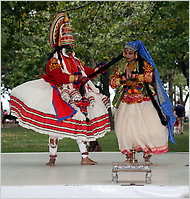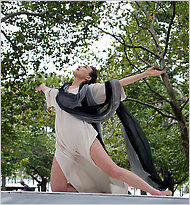
| Outdoor Festival |
| Performer Bios |
| Program Synopsis |
| Press Release |
| Photos |
| Preview |
| Review |
| Call for Submissions |
| www.nytimes.com Cultures Converge on Battery Park August 16, 2010 By ALASTAIR MACAULAY |
||||||||||||||||||||||||||||||||||||||||
With tireless good humor, Jonathan Hollander, the artistic director of the Battery Dance Company, presents and thanks each troupe. Aware that many members of the audience stay only part of the time, he cheerfully recycles some of the information. For the most part, companies based in downtown New York are presented, but a few come from far and wide. This year troupes from Connecticut, upstate New York and Japan appeared. And for three years now, the festival has deliberately overlapped with the Erasing Borders festival of Indian dance, presented by the Indo-American Arts Council. (Though the Kathakali company Guru Radha Mohanan & Troupe appeared on the bill over the weekend, it will appear at great length this week, and I will review it later.) The dances from India (traditional Kathakali) and Japan (modern but with specifically Japanese elements) alone would have made the weekend’s performances multicultural. The surprise was that two of the American-based companies were evoking other cultures too. C. Eule Dance, a modern-dance company based in New York City, performed “Passage to Marrakech,” with veils, lanterns, carpets and movement all referring to Morocco. Amy Marshall’s “Vortex,” to music by Rejendra Pressana, though ritualistic and gymnastic, had strong hints of Bollywood. This American interest in the “exotic” aspects of Asian culture goes back to Denishawn and the earliest days here of modern dance (sometimes labeled premodern). Another aspect of those early days came with “The Art of Isadora,” presented by Lori Belilove & the Isadora Duncan Dance Company. The festival’s atmosphere is friendly and accessible. But the downtown dance scene has a reputation for challenging experimentalism, an aspect I don’t see represented here. Modern dance and modern ballet were performed almost invariably to music, with no movement elements looking more novel than elements of the wavelike impulses and stress reductions of release technique. Several companies showed women supporting and lifting men and other women (though at least one — Buglisi Dance Theater, in excerpts from Jacqulyn Buglisi’s “Love Letters on Ripped Paper,” created a world in which men don’t dance with women, they only partner them, usually in extensive lifts). The Yuko Takahashi Dance Company seemed to be doing modern dance with the enthusiasm of people trying on exotic new clothes, very much aware of the exciting effects they were making — and the actual clothes were marvelous — but the choreography inclined to vague but attention-claiming indications of mood. Some of the most focused dancing came from the six performers of the Battery Dance Company itself. Mr. Hollander presented two pieces, each to a score donated by the composer: Lukas Foss and Meredith Monk. The Monk work, “Voice Hearers” (2009), is the more substantial, a mainly pure-dance work of shifting geometries and formal interest, undercut by a drama about characters hearing real or imagined accusatory voices. (“Nobody likes you, and you’ll be alone for the rest of your life.”) The graceful objectivity of Joshua Tuason’s dancing made a particularly fine impression in two pieces by Lane Gifford, performed by Lane & Co.: “Off White” (a trio suggesting one woman’s jealousy of, and separation from, another male-female relationship) and the dance sextet “Bi-Coastal.” The two female performers of Blakeley White-McGuire’s “Woman,” Jacqueline Elder and Ms. White-McGuire, moved together through a range of dance moods — adagio with mutual partnering, separate floorwork, traveling with jumps — with elegant control throughout. The 19 children who performed in three pieces choreographed by Susan Slotnick for her Figures in Flight Dance Company (from upstate New York) included only one boy, Ryan Ludwig. While he was almost its smallest member, he was also perhaps its best, precisely showing the accentuation of each step and, at the end of each work, taking a flying jump off the raised stage with infectious enthusiasm. But most of the weekend’s companies gave us choreography that was generic rather than specific, expressive in overall mood rather than in drama. James R. Atkinson’s “Lush Mechanique,” for the company he directs, Classical Contemporary Ballet Theater (from Connecticut), is striking in the ways he tips ballet beyond convention, but it’s more a set of stylistic options than coherent choreography. The “Marrakech” offered by C. Eule Dance is just an array of jolly tourist impressions (and never once as interesting as the belly dance I remember from my own visit to Marrakesh). Ms. Marshall’s “Vortex” is very earnest in its suggestions of Indian-type rituals, but really its gymnastics and groupings would have been better served in a more cheerfully Bollywood style. Ms. Belilove’s “Art of Isadora” occasionally feels dramatically vague, and formulaic in its choice of movements, but the style of Isadora Duncan is rendered honestly, without exaggeration, so that we’re often made to think, “She and her followers really may have moved like that.” The Downtown Dance Festival runs through Friday with performances at 1 New York Plaza, at Water and Whitehall Streets, Lower Manhattan; batterydanceco.com. |
||||||||||||||||||||||||||||||||||||||||
| Source: http://www.nytimes.com/2010/08/17/arts/dance/17battery.html?_r=2 |




